Northern university student population health and physical progress profiling study
ˑ:
PhD, Associate Professor I.A. Pogonysheva1
PhD, Associate Professor D.A. Pogonyshev1
Master V.V. Postnikova1
1Nizhnevartovsk State University, Nizhnevartovsk
Keywords: students, health standards, physical progress rates, functionality rates, somatic health rates, anthropometrical characteristics.
Introduction. National student population health and physical progress profiling studies appear to be increasingly topical nowadays. Monitoring of the adolescents’ growth and development process falls within the competence of various sciences, among the most relevant areas of which is diagnosis of the "temporal" changes in the physical progress rates - longitudinal studies. Nowadays, the scientific literature contains a great deal of evidence that the physical progress and functionality rates in the younger generation are decreasing [1-10].
According to a number of scientists, student age is one of the critical stages of ontogenesis. The increasing level of informatization, the strain of modern life, sedentary lifestyle, psychophysiological and psychosomatic dysfunctions lead to lowered health standards of student youth. Dynamic physiological changes in the students’ body, their socialization, as well as hypocomfortable conditions of the Khanty-Mansi Autonomous Region - Yugra aggravate the tension of the mechanisms of adaptation.
Objective of the study was to find the gender-specific physical progress trends and analyze the health situation.
Methods and structure of the study. We conducted a long-term systematic study of the main somatic health rates and anthropometrical characteristics of the Nizhnevartovsk State University students. Using a cohort-consistent research method, we monitored the physical progress and functionality rates in the 17-19 year-old students living and studying on the territory equivalent to the Far North regions for 15 years. Sampled for the study were 926 females and 768 young males. During the study, we measured their body mass and length, chest circumference, determined the muscle strength of the dominant hand (wrist) and vital capacity (VC). The muscle strength of the wrist was determined by means of a spring dynamometer. VC was measured using a portable dry spirometer. We calculated the arithmetic mean (M) and error of mean (m) of the main somatic health and functionality rates, and used the Student's t-test to determine the statistical significance of the research results.
The dynamics of changes in the physical progress rates of the young males and females (2003-2018) is presented in Fig. 1-3.
Results and discussion. The analysis of the somatic health rates revealed pronounced sexual dimorphism; the mean values of the body length and mass in the male students were higher than in their peers of the opposite sex.
The comparative analysis of the students’ physical progress rates for the period of 2003-2018 showed that modern young people are superior to their peers examined in 2003 in terms of the basic somatic health rates. There was a distinct synchronous increase in the body length and mass indices from 2003 to 2012 in the females and from 2003 to 2014 in the young males. As opposed to 2003, the body length of the students of both sexes increased statistically significantly (see Fig. 1).
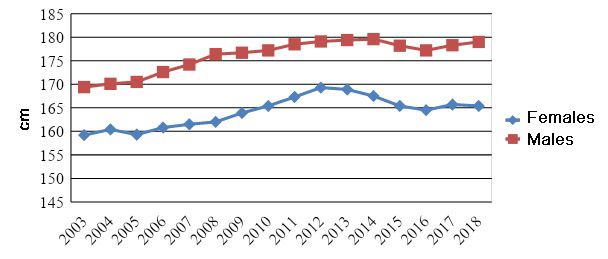
Fig. 1. Body length in young males and females (cm)
There were no statistically significant differences between the body mass indices registered in the females. The young males were found to have a significant increase of their body mass in 2011 (76.3±1.8 kg), 2012 (76.5±1.6), 2013 (76.9±2.0), 2014 (78.1±1.9), and 2018 (81.8±2.1) as opposed to 2003 (66.1±1.9) (see Fig. 2).
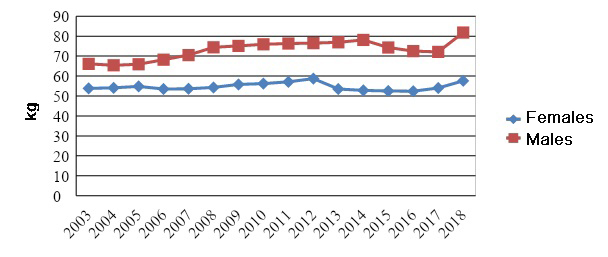
Fig. 2. Body mass in young males and females (kg)
In 2018, the chest circumference indices in the females decreased statistically significantly (74.3±1.7 cm) as compared to 2003 (86.4±1.9 cm). There were no significant differences between these indices in the young males (see Fig. 3).
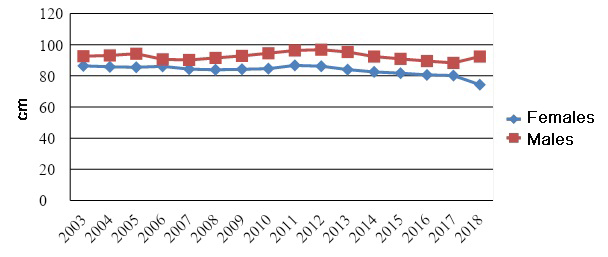
Fig. 3. Chest size in young males and females (cm)
The physical progress rates are interconnected with the functional ones, in particular with the strength capabilities. The dynamics of changes in the statistical parameters of the students’ grip strength is presented in Fig. 4. The subjects of both sexes were found to have a statistically significant decrease in their functional indicators. We observed significant differences in the strength indices (measured by means of dynamometry) in the young males in 2012 (37.6±1.5 kg), 2013 (37.8±1.9 kg), 2014 (37.5±1.6 kg), 2015 (37.2±1.8 kg), 2016 (35.9±1.9 kg), 2017 (34.5±1.5 kg), and 2018 (37.2±1.8 kg) as compared to 2003 (45.4±2.1 kg); and in the females - in 2014 (24.9±1.8 kg), 2015 (23.5±1.9 kg), 2016 (22.6±1.6 kg), 2017 (22.1±1.8 kg), and 2018 (24.4±1.6 kg) as compared to 2003 (32.5±2.3 kg) (see Fig. 4).
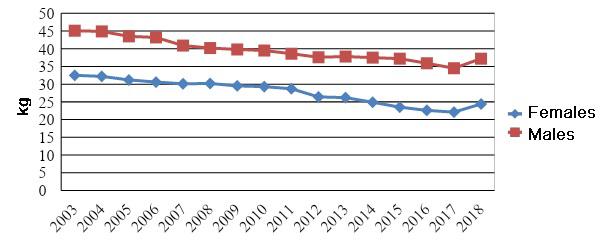
Fig. 4. Muscle strength of right wrist of young males and females (kg)
The publications representing a decrease in the functionality rates of children, adolescents and youth in the XXI century can be found in different regions of Russia [2, 3, 6]. Decreased strength capabilities are associated with the growth in the use of information technologies in everyday life, a lack of interest in active physical education and sports activities, a switch to other forms of entertainment, the range of which has been significantly expanded these days, poor nutrition; among the aggravating factors are ecological problems and social risk factors.
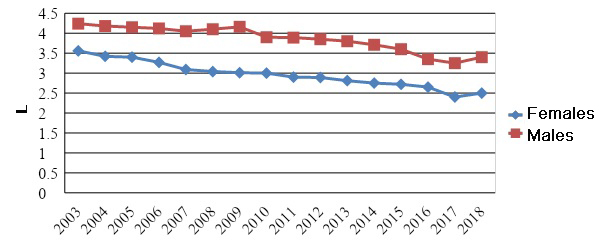
Fig. 5. VC rates in young males and females (L)
The dynamics of changes in the VC rates in the examined students is presented in Fig. 5. The subjects of both sexes were found to have a decrease in the anthropometrical characteristics of the respiratory system. The young males’ VC rates differed significantly from those registered in the period from 2013 to the present day as opposed to 2003 (see Fig. 5).
Conclusion. A comparative analysis of the physical progress data for the period of 2003-2018 showed the highest progress in the somatic health rates; plus progress in the male/ female anthropometrics; and meaningful changes in the body length and wrist dynamometry rates and the vital capacity rates – with the latter two tested to notably fall for the 15 years. On the whole, the Northern students’ physical progress trends may be summarized as follows: growths in the body anthropometric characteristics and falls in the strength rates – with the finding confirmed by the relevant studies in some other Russian regions.
References
- Baranov A.A., Kuchma V.R., Skoblina N.A. Fizicheskoe razvitie detey i podrostkov na rubezhe tysyacheletiy [Physical development of children and adolescents at the turn of the millennium]. M.: Scientific Center of Children's Health, Russian Academy of Medical Sciences, 2008. 216 p.
- Kuznetsova M.V. Osobennosti fizicheskogo razvitiya studencheskoy molodezhi Orenburzhya [Features of physical development of students in Orenburg]. PhD diss.. Orenburg, 2005. 119 p.
- Kuchma V.R., Skoblina N.A., Milushkina O.Yu. et al. Kharakteristika morfofunktsionalnykh pokazateley moskovskikh shkolnikov 8-15 let (po rezultatam longitudinalnyih issledovaniy) [Characteristics of morphofunctional indicators of Moscow students aged 8–15 years old (based on longitudinal studies)]. Vestnik Moskovskogo universiteta. Ser. 23: Antropologiya. 2012. no. 1. pp. 76-83.
- Lebedev A.V., Rubanovich V.B., Aizman N.I. et al. Morfofunktsionalnye osobennosti studentov pervogo kursa pedagogicheskogo vuza [Morphofunctional features of first-year students of pedagogical university]. Vestnik NGPU. 2014. no. 1 (17). [Elektronnyiy resurs]. Available at: https://cyberleninka.ru/article/n/morfo-funktsionalnye-osobennosti-stude... (date of access: 15.03.2019).
- Lebedeva T.B., Baranov A.N. Tendentsii fizicheskogo i polovogo razvitiya devochek i devushek na severo-zapade Rossii [Physical and sexual development trends in girls in North-Western Russia]. Ekologiya cheloveka. 2007. no. 9. [Electronic resource]. Available at: https://cyberleninka.ru/article/n/tendentsii-fizicheskogo-i-polovogo-raz... (date of access: 14.02.2019).
- Mishkova T.A. Morfofunktsionalnye osobennosti i adaptatsionnye vozmozhnosti sovremennoy studencheskoy molodezhi v svyazi s otsenkoy fizicheskogo razvitiya [Morphofunctional features and adaptive capabilities of modern students in connection with physical development rating]. PhD diss. abstr.. M., 2010. 24 p.
- Pogonysheva I.A., Pogonyshev D.A. Osobennosti morfofunktsionalnykh parametrov organizma molodykh lyudey, prozhivayushchikh v raznykh klimatogeofizicheskkh usloviyakh okruzhayushchey sredy [Features of morphofunctional parameters of young people living in different climatic and geophysical environmental conditions]. Vestnik Nizhnevartovskogo gosudarstvennogo universiteta. 2017. no. 1. pp. 68-74.
- Pogonysheva I.A., Pogonyshev D.A., Gureva A.V. Monitoring morfofunktsionalnogo sostoyaniya organizma studentov KhMAO-Yugry [Monitoring of morphofunctional state of students of KhMAO-Yugra]. Byulleten nauki i praktiki. 2016. no.12 (13). pp. 84-91.
- Baranov A.A., Kuchma V.R. [ed.] Fizicheskoe razvitie detey i podrostkov Rossiyskoy Federatsii [Physical development of children and adolescents of the Russian Federation]. Col. works (no. VI). M.: PediatrЪ», 2013. 192 p.
- Yampolskaya Yu.A., Skoblina N.A., Bokareva N.A. Longitudinalnye issledovaniya pokazateley fizicheskogo razvitiya shkolnikov g. Moskvy (1960-e, 1980-e, 2000-e gg.) [Longitudinal studies of physical development rates of schoolchildren in Moscow (1960s, 1980s, 2000s)]. Vestnik antropologii. 2011. no. 20. pp. 63-70.
Corresponding author: severina.i@bk.ru
Abstract
National student population health and physical progress profiling studies appear to be increasingly topical nowadays. The study was designed to profile on a multiannual (2003 to 2018) systemic basis the somatic health and physical fitness rates and anthropometrics of the Far Northern student population. Objective of the study was to find the gender-specific physical progress trends and analyze the health situation. Sampled for the study were the first-year NSU students whose anthropometrical characteristics (body mass and length; chest size), functionality (lead wrist strength and vital capacity) were tested. The tests showed a clear simultaneous body length and mass growth trend since 2003 till 2012-2014 in the female and male groups, respectively. A comparative analysis of the physical progress data for the period of 2003-2018 showed the highest progress in the somatic health rates; plus progress in the male/ female anthropometrics; and meaningful changes in the body length and wrist dynamometry rates and the vital capacity rates – with the latter two tested to notably fall for the 15 years. On the whole, the Northern students’ physical progress trends may be summarized as follows: growths in the body anthropometric characteristics and falls in the strength rates – with the finding confirmed by the relevant studies in some other Russian regions.


